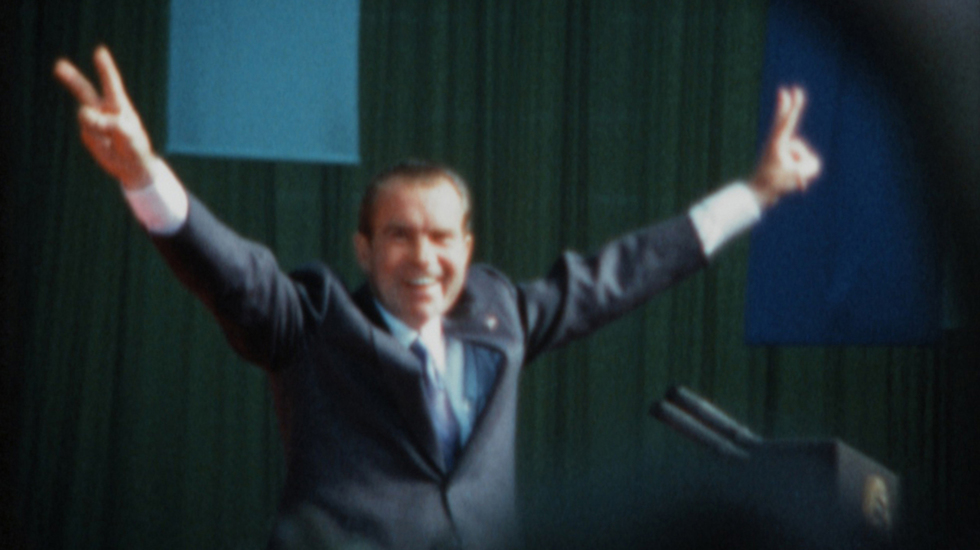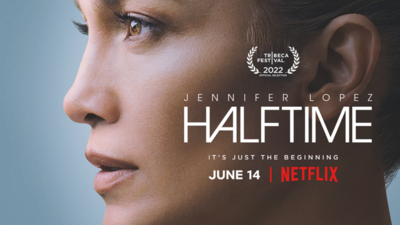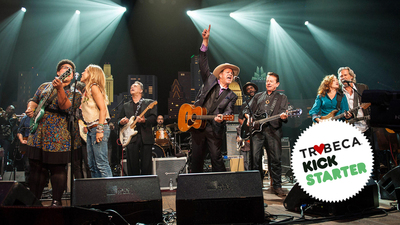
BY KAREN KEMMERLE |
‘Our Nixon’ Director Penny Lane on Kickstarter’s Early Days and Doc Trends She Hates
Ever wanted to be a fly on the wall in Nixon’s Whitehouse? Penny Lane’s ‘Our Nixon,’ a riveting compilation of never before seen Super 8 home movies shot by the President’s staff, is in theaters now.

In her first feature length documentary, Penny Lane takes audiences inside the Nixon White House through home movie footage compliments of three of his top advisors: H.R Haldeman, John Enrlichman and Dwight Chapin. The trio shot a remarkable 500 reels of film from 1969 to 1973, catching notable public events and intriguing private interactions that took place during Nixon’s regime.
Through this all-archival documentary, Penny Lane constructs an interesting, complicated and intimate portrait of our 37th President through the eyes of his loyal staffers in Our Nixon. She spoke to us about the idea of “company men,” working with the Nixon library and why she hates the production process.
Tribeca: While you’ve been making documentaries for almost a decade, Our Nixon is your first feature-length film. How familiar with the Nixon administration were you before your starting making this documentary?
Penny Lane: I would say…as familiar as you probably are. I had the knowledge of your average, college-educated person who took a few history classes. I was not an expert or obsessed or anything. It wasn’t like I had always wanted to make a Nixon movie.
Tribeca: What challenges did you encounter while making a feature length documentary that were different from the challenges that come with making short documentaries as you had done in the past?
PL: The biggest one was that I was used to doing everything myself. And, you can – I’m a good editor, I can do whatever. The biggest challenge was getting to the point of realizing that I didn’t want to do everything myself. I guess I could have, but it wasn’t going to be as good of a film as I wanted it to be unless I figured out how to be a “director” in a more traditional sense. I’d never done that before.
Because I’d never done that before, I’d also never dealt with raising the amount of money needed to marshal a somewhat substantial crew. In our case it was all post-production, but we still needed crew. There was a difficult period of time when I knew the people I wanted to be on the team but I hadn’t yet raised the money to build the team. Without the team, I knew I couldn’t make the kind of quality film that would attract investment. It was a dilemma.
We were lucky though in that we had to deal with uncertainty for only a few months— for a lot of filmmakers, things are up in the air for years.
Tribeca: Did you ever turn to crowdfunding?
PL: We did. We had spent $18,000 to make the first round of video transfers so we did a crowdfunding campaign a couple months later to recoup that money and get back to “zero.” That was pretty early in the Kickstarter days, and I didn’t have any friends who had used Kickstarter before. It was March of 2011, so it was over two years ago.
We raised $16,000, which was, at the time, a pretty significant amount of money on the platform. I mean, now people raise $1.25 million, so it wasn’t the biggest deal in the world – but for us it was crazy amazing. It was amazing, too, because the appeal wasn’t as much about the money as it was about the viability of the project.
Yes, we paid ourselves back for this initial investment with that funding, but what it really did was a market test. We found out how many people were really excited about this film, and I don’t think we would have had any way to know that unless we had thrown it out into the world and gotten the kind of response we got. We ended up meeting our executive producers because of the Kickstarter campaign through a lot of really early press and buzz. It wouldn’t have happened if we hadn’t done the Kickstarter.
 Tribeca: I thought it was really fascinating that your team paid to make digital copies of the home movie collection from the Nixon Library to use the films in your documentary. Can you talk about your negotiations with the library? Were they at all apprehensive about what you’d reveal?
Tribeca: I thought it was really fascinating that your team paid to make digital copies of the home movie collection from the Nixon Library to use the films in your documentary. Can you talk about your negotiations with the library? Were they at all apprehensive about what you’d reveal?
PL: Oh no, they wanted someone to do that. You know, someone’s got to pay to have the stuff made accessible. It was technically in the public domain; it was just that there wasn’t any funding from the federal government/national archives system to make every single thing that’s ever come through their doors accessible. So they have all this material but the great majority of it has never been digitized. They rely on the interest of individual researchers to come and say, “I want to digitize that film,” because then the duplicate copy of that digitized film becomes available to the next researcher.
Tribeca: Have representatives from the library seen the film?
PL: Sure! The audio/visual archivist—Ryan Pettigrew—was the person we worked with the most, and he has definitely seen the film. The Nixon Library is part of the federal government; it’s not they are Nixon partisans who are afraid of things. Also, what would they be afraid of in these home movies? They are hardly incriminating.
Tribeca: It was so interesting to watch Nixon at a wedding and making a phone call – it seemed like he carried on a much more personal presidency than leaders today. How did you react to the home videos knowing what kind of interaction the public has with recent and current politicians?
PL: I don’t think we get to see those kinds of images today. Barack Obama I follow on Twitter, but I don’t really think it’s him. There’s kind of a pretense of that sort of “personal access,” but I don’t think it’s real.
As an artist, I have come to accept and embrace the idea that I’m more interested in finding things out than making fictional worlds.
Tribeca: Not a single frame of film was shot for this documentary; all the footage came from the Super 8 movies shot by H.R. Haldeman, John Ehrlichman and Dwight Chapin. What first sparked your interest in these home remarkable home movies? How did you first hear about these existing tapes?
PL: My co-producer, Brian Frye, had heard about the tapes around 2002, so 10+ years ago. Of course, it required an $18,000 investment just to see these tapes. When Brian initially heard about the tapes, he was was a pretty broke artist in his 20s. When he told me about it, I was really intrigued as well, and we figured there’d be something worth $18,000 in there.
We didn’t really even know what. We thought we might make a video installation – we both come from a fine arts background – so we were very open-ended about what the project might end up being.
Tribeca: Before seeing the film, I really didn’t know much about the three men who are the focus, H.R. Haldeman, John Ehrlichman, and Dwight Chapin –
PL: You and me both.
Tribeca: It was so interesting to learn about this idea of the “company man.” The loyalty of the three men really surprised me. They never said anything disparaging about Nixon during the entire ordeal, even when he didn’t have the guts to ask them for their resignations himself. Is the idea of the “company man” now gone from American politics?
PL: Yeah! I’m glad that you said that – I love that idea. I thought about it a lot when we were making the film. They were total “company men” in a way that is so hard to relate to. I don’t know if those types of people still exist. Dwight Chapin started working for Nixon when he was 18 years old. Haldeman started working for Nixon when he was very young as well, same with Ehrlichman – they devoted the vast majority of their adult lives to this man without really asking for very much in return.
You see in the footage that at times they have criticisms of, or suspicions of, Henry Kissinger. They don’t see him as having the correct attitude of a White House staffer, of a “number two man.” They believed that staffers had to be egoless people whose only purpose was to execute the President’s desires. All of their discussions of Kissinger reflected their opinion that he was in it for himself. He didn’t fit into the image of what they believed their role to be.
I was also struck by the respect that Chapin, Haldeman and Ehrlichman had for the Office of the Presidency – not just for the President himself. They had this deep, abiding honor for the idea of the “Office of the Presidency.” And what’s so, of course, ironic about the whole film – there’s so much irony that we had to dial it back – is that these people who had such respect for the institution ended up doing so much damage to the image of the Presidency.
It’s worth saying that Ehrlichman acted differently toward the end. Haldeman and Chapin were company men to the very end, but not Ehrlichman. He obviously felt betrayed and was very vocal about feeling that he had been ill-used by the President. He never saw Nixon again after he left the White House. He wrote tell-all memoirs and felt free to criticize Nixon later in life.
 Tribeca: This film revealed the many sides of Richard Nixon. From oddly sweet moments like the moon landing phone call to the raging homophobic conversation about “All in the Family,” I think I’m more confused then ever about how I feel about the man.
Tribeca: This film revealed the many sides of Richard Nixon. From oddly sweet moments like the moon landing phone call to the raging homophobic conversation about “All in the Family,” I think I’m more confused then ever about how I feel about the man.
PL: Oh I’m so glad!
Tribeca: What was the most surprising thing you learned about the former president while watching the footage?
PL: I don’t know that there was anything specific I learned about Nixon that was surprising. What I was more surprised by was, as I started doing all the research that you can imagine it took to make the film, the way that the story I had inherited was clearly so flat, so black and white. Going back into primary sources and trying to experience history – history in the present tense – reveals how complicated it really was.
So you have this caricature that you’ve been handed, and then when you go back and you really look at the way things unfolded – the daily news, the home movies, the tapes, whatever – it’s all of the stereotype and more. History is always more complicated than you think it is. It’s why I was so committed to going back to original source material and doing this kind of archival film. There are things about history that you can’t learn any other way.
When you think of all the Nixon movies in which he is always portrayed as a psychotic, paranoid, sweating monster, you have to wonder how a guy could be elected president who acted like that all the time. Obviously, when you think about it, you realize that he wasn’t like that all the time. You do see in our film that in private conversations he was not always statesman-like, but at other times he was. For me, the surprise was that the closer I looked at the workings of the Nixon White House as revealed in the footage, the more complicated things got. And that goes for all of it – Watergate, Vietnam, all of it.
Tribeca: Do you think you’d be interested in doing another archival film like this? Is there another story you’d like to work with?
PL: Oh yeah. Brian and I have done archival projects almost exclusively for a number of reasons. As an artist, I have come to accept and embrace the idea that I’m more interested in finding things out than making fictional worlds. I don’t like pointing a camera at people. I think it’s very awkward. I feel like a terrible person. Even if you’re at my house and you’re my friend and it’s a dinner party and I want to take a picture, I feel bad. I just don’t like it.
I don’t really like anything about production, but I like everything about post-production. On a different level, it’s a little bit of a niche in the sense where there aren’t very many filmmakers who are combing through these kinds of historical documents and looking for material. So it’s a place I can go where I don’t feel like I’m competing with everyone in the world.
Tribeca: To bring up another female documentary filmmaker, Sarah Polley just made the fantastic Stories We Tell that mixed archival footage and fictionalized reenactment. Would you ever consider doing a film like that?
PL: Well, that’s my next film. It’s based on five years of very intense, archival research, but it became very evident that I needed to have reenactment. So the next film I’m doing is very heavy on the reenactments. They are 30% of the film. However, all the reenactments are animated. I still don’t want to point a camera at anybody. I am happy to record your voice, though, if you’re a voice actor!
There are many documentary filmmakers who seem to want to end conversations as opposed to start them.
Tribeca: It’s weird – you feel this emotional pull towards all four of the men, including Nixon. Did you face any criticism from portraying Nixon differently?
PL: Oh yeah. Totally! It was the least interesting criticism in the entire world to me. I had to wonder what was wrong with critics who were actually having a hard time accepting that this was a person.
In the documentary film world, there are documentary films about pedophiles, serial killers, rapists and murderers who audiences come to empathize with. They realize that these criminals are people too and are interested in what could have led them to these terrible crimes. This is a very, very common theme in documentary film, perhaps because the audiences tend to be heavily left.
Honestly, we were concerned about that; we didn’t want to turn anyone off. We didn’t want to lose or alienate a huge chunk of our audience by not acknowledging the darkness surrounding Nixon. For the most part, though, we just stuck to humanistic themes inherent in Nixon’s story, like betrayal, power, brotherhood, and loyalty. It was important to us that the film unfolds like a human drama that happened to be set against these very famous, historical events.
We joked about having a “disclaimer” for a while: “We know he did really bad things…moving on.” In the end, those criticisms still exist. There are plenty of people who think that we were too gentle on this very terrible monster – but there are at least an equal number of people who think that this is just another example of Nixon bashing. So we did our job. What better thing could I ask for?
Tribeca: Right. The goal, I think, of any documentary film is to invoke conversation.
PL: I would hope so. There are many documentary filmmakers who seem to want to end conversations as opposed to start them. That’s not the kind of filmmaker I am. “Here’s everything you need to know about this about the subject” is actually a more common form of documentary than something that says, “well, let’s think not about what we know, but about what don’t we know about this.” That approach is just more exciting to me, but it is why certain career paths are closed to me. Let’s put it that way.
Tribeca: Is there any “trend” in the documentary film world that you’re eager to see go away?
PL: I think I just said it – I’m just so bored with social issue movies that want to take a really complicated subject and try to make it simple. I feel like any intellectually honest person can acknowledge that the more you look at something, the more complicated it gets. Audiences should not be treated like they’re stupid. They can tell if the filmmaker is deliberately leaving out any reasonable point of view that disagrees with his or her own.
Tribeca: What is the last truly great documentary that you watched?
PL: The Act of Killing. It’s so in its own category that I feel reluctant to even describe it. There’s a lot of amazing films, but The Act of Killing is a once-in-a-century, life-changing, paradigm-shifting kind of film. Thank God for Joshua Oppenheimer.
Our Nixon is currently in select cities across the country.

